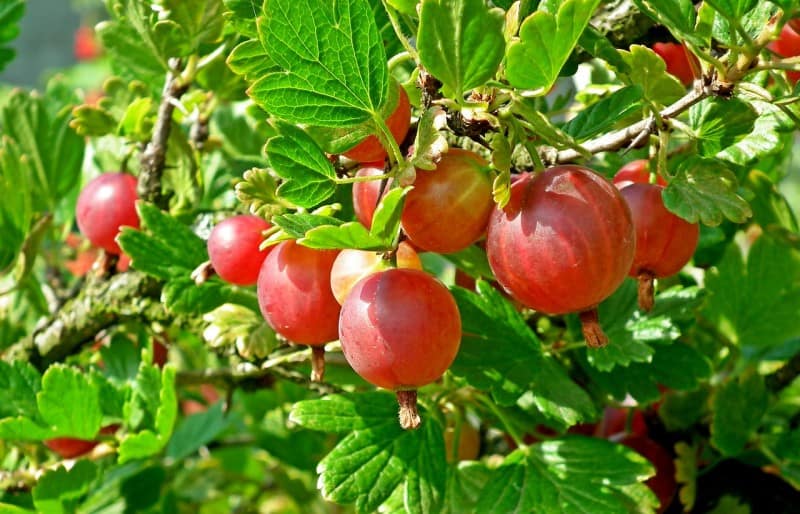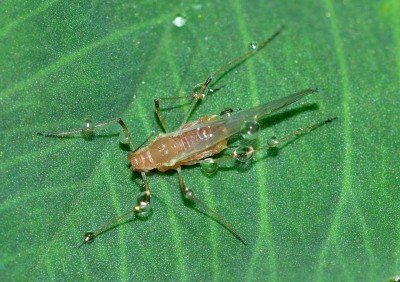Are you looking for a fruit bush that’s easy for beginners to grow? Gooseberry bushes grow well in most areas, and they’re self-pollinating, so you can plant just one. Learning how to grow gooseberries is excellent for beginners; they’re a forgiving plant.
If you live in America, you might not know about gooseberries. They’re not a well-known American plant; they’re more famous in Britain. Gooseberry plants are everywhere in the U.K., and the country even hosts competitions to see who can grow the most abundant and sweetest fruits.
American doesn’t have the same fascination for growing berries in their garden, but it’s finally starting to become more popular. Gooseberries are abundant, easy to care for, and delicious. So, if you want a plant that can be left to its own devices and still produce a harvest for jams and desserts, gooseberries are for you.
Table of Contents:
Types of Gooseberries
Gooseberries come in two varieties: culinary and dessert.
Culinary gooseberries have a naturally sour taste, so they need to be cooked with sugar to reduce that sourness. You can use culinary gooseberries in jams, pies, and puddings.
Dessert gooseberries can be eaten right off the bush because they’re naturally sweet. Most of the time, unless you grow your gooseberries, you won’t encounter dessert gooseberries.
Then, these gooseberries are broken into four different colors: green, white, red, and yellow. You can find European and U.S. varieties.
Let’s take a look!
Green Gooseberry
- Invicta: This is an English variety, and it’s one of the most common types. The bush creates pale, green berries that ripen in July.
- Careless: Careless is an early bloom that produces general, all-around berries. It’s hardy, handling a variety of soils.
White Gooseberry
- Langley Gage: This bush produces large, thin-skinned white berries on a medium-sized bush. It’s a famous English type, and it creates yummy dessert berries.

Red Gooseberry
- Rokula: You’ll love this Germany gooseberry that is mildew resistant, and it produces fruit a week earlier than other ones. It has a compact growth habit, producing dark red, sweet berries.
- Winham’s Industry: Here is a U.K. variety that is the gold standard for dessert gooseberries. Winham’s is a vigorous grower that handles most soil types and ripens in late July.
- Poorman: This is an American gooseberry that thrives and has small thorns. It’s mildew resistant and produces large berries.
Yellow Gooseberry
- Golden Drop: This variety ripens mid-season with plenty of medium-sized fruits. It’s a compact bush that grows upright.
- Leveller: It’s a mid-season bloomer that produces yellow berries and large yield. The garden needs to have fertile soil to create a yield, but the berries are delicious dessert berries.
How to Grow Gooseberries
Once you pick the varieties that you want to grow, it’s time to figure out how to grow gooseberries in your backyard.
Remember that gooseberries are hardy plants that can survive plenty of frosts. Some varieties are hardy up to -40℉ (-40 Celsius).
If the temperatures reach over 90℉, so they won’t produce well in warmer climates. Gooseberries grow well in USDA Hardiness Zones 3-8.
Where to Grow Gooseberries
Gooseberries grow well in most gardens, but they do best when in an area with full sunlight and rich, well-draining soil. Many sure you pick a location that receives morning sun and afternoon shade or some parts of shade throughout the day.
Remember that gooseberries grow into bushes, but you can train them to grow against a fence as fans or single-stemmed cordons. Think about the fact that these are bushes when you pick the location to grow gooseberries in your backyard.
Believe it or not, gooseberries can be grown in containers, so if you don’t have tons of space for the bushes, don’t fret!
Preparing the Soil for Gooseberries
These berries prefer to have fertile soil that’s amended with compost. Before you plant gooseberries, test the soil to determine the pH level; they prefer a level of 6-6.5.
Once you figure out the pH level and make any amendments needed to achieve the right level, add compost or well-rotted manure to the soil. Most soil also benefits from the addition of shredded peat moss instead of compost.
Gooseberries prefer moist, well-draining soil. Waterlogging isn’t a friend for these bushes, so you do want to make sure you improve the structure of the earth. If you know the soil isn’t draining, add compost, peat moss, sand, or a soil conditioner to loosen the dirt.
How to Plant Gooseberries
The best time to plant gooseberries is from late fall to early spring. In many places, you’ll need to wait until spring because the ground freezes solid.
Digging in frozen ground isn’t fun, and it won’t give the roots the time to spread out and establish. So, October and November are ideal months to plant these bushes.
Potted gooseberries can be planted between autumn and spring because they already have a small, root system established. The roots don’t have to grow into the frozen ground.
You’re going to plant either bare-root bushes or container-grown gooseberries. Dig a large hole for planting. If you didn’t add manure or compost to the area before you plant, add some well-rotted compost or manure to the removed soil.
Put the gooseberry bush into the hole and make sure the previous soil level is flush with the new soil level. Then, fill the hole back in with the enriched soil. Make sure to press down firmly on the soil to get as much of the dirt back into the hole.
After you pack the soil back into the hole, water thoroughly to settle the soil into the hole and then add mulch over the replaced soil as well. Mulch helps to suppress the weeds and feed your new plant as the much decomposes.
If you plant more than one gooseberry bushes, they need to be at least 4 feet apart. If you want to go the cordon route, you can plant the bushes closer, around 18 inches apart.
Growing Gooseberries in Containers
If you lack space, gooseberries can be grown in containers, but you do want to make sure that the pots don’t get waterlogged or be faced with dry soil. Always keep an eye on the soil moisture content.
Gooseberries need to be watered frequently when they’re in pots, especially when the fruits are forming.
Make sure you have containers that are at least 18-inches deep. The pot needs to be filled with a mixture that is half potting soil and half potting compost.
Caring for Gooseberries
Now that you have the bushes in the soil, you have to take care of the gooseberry plants correctly.
Watering
Gooseberries need regular watering, especially for young plants. In the beginning, you should water regularly to help the plants establish in the soil.
The same goes for container-grown gooseberries, which need to be watered regularly for their entire lifespan because their roots can’t dig deeper for water.
Once your plants are established, apply mulch around the root area, and you can water every two weeks deeply. If you have hot and dry spells, you should water a bit more than that.
Should You Fertilize Gooseberry Bushes?
Yes, gooseberry bushes need to be fertilized. Apply an organic, balanced fertilizer at the end of each winter to help to give the plants a head start in the new growing season. Make sure you don’t add too much nitrogen because it puts the plant at risk for mildew.
Throughout the growing season, gooseberries love a boost of potassium. You should plan to feed these bushes monthly from early spring until harvest time. Another option is using a tomato-feed fertilizer or a 5-10-10 liquid fertilizer. Liquid tomato feed has a lot of potash.
How to Prune Gooseberries
Pruning gooseberry bushes help to encourage an open, evenly spaced branch structure. It’s an integral part of their care because it allows for ample light and air circulation, both of each discourage diseases from taking root in your bushes.
Pruning takes place in winter when the bush is dormant for the season. Here is how you prune gooseberry bushes.
- First, cut off all of the dead or diseased wood, shoots that are too close to the ground, or tangled and overcrowded branches.
- Then, prune the branches that are left. Cut back the previous season’s growth by half, and cut the side shoots as well. You should cut them back between one and three buds from the base of the stalk.
- Dig up any stems, called suckers, growing from the ground away from the main stem.
Common Diseases and Pests
While gooseberries are generally pest and diease resistant, that doesn’t mean there aren’t a few that might cause some problems along the way.
Gooseberry Mildew
If you notice a powdery grey and white fungus on the leaves and stems on your plant, you probably have gooseberry mildew. Gooseberry mildew spreads over the fruit, so it can cause problems with ripening.
You’ll have to remove any part of the infected steam and leave, destroying them properly. Make sure your plants aren’t spaced close together, so you can have adequate air circulation.
Gooseberry Sawfly
These pests are a pale green larvae that look very close to caterpillars, and gooseberry sawfly cause rapid destruction of your plants. They can reduce the bushes down to just stems quickly, and you’ll see the destruction in the middle to late spring. Problems can start well into the summer.
Anthracnose
This fungus causes masses of spores to develop on your plants, destroying your harvest. You can purchase resistant varieties if you struggle with anthracnose.
Make sure that you disinfect your tools between each use. Destroy any pruned branches that are infected. Gardeners can use a liquid copper spray or a sulfur powder in the early spring to help prevent the development. Neem oil in the spring can destroy bugs that spread anthracnose.
Currant Cane Blight
New England is the host of currant cane blight, and it can kill off a bush in as little as two years. The plants will develop shriveled fruits, and new growth will turn pale brown. Remove and destroy infected canes in the spring and fall. You’ll also wnat to spray plants with an antifungal treatment.
White Pine Blister Rust
Gooseberry plants host white pine blister rust, and it’s a threat to high elevation pine trees. Ideally, make sure you plant your gooseberries near white pine trees, and make sure to destroy any plants that are infected.
Plants develop cankers, and that’s how you know that you have white pine blister rust.
Currant Borer
These pests look like blue-black moth with clear wings, and they lay eggs at the base of the plants. Remove the infested canes and destroy them. Parasitic wasps can help to be sure currant borers stay away.

Aphids
Aphids take over almost every garden, and they suck the sap out of plants, spreading disease. On the underside of the leaves, look for groups of white, green, or brown bugs.
To get the aphids off of the leaves, spray the plants with a blast of strong water. Then, treat the leaves with neem oil to keep aphids away.
Birds
As with any berry bush, birds are a natural pest that can destroy your gooseberry plants quickly. Pigeons love gooseberries, but who can blame them? Gooseberries are a delicious yummy snack, and they can cause problems by eating the fruits, leaves, buds, and seedlings.
It’s best if you put a net or fleece over top. Try scarecrows and bird-scaring devices; they can work, but covering is the best long-term choice.
Harvesting Gooseberries
One thing you need to do is cover the plants with netting or grow them inside of fruit cages. The birds love gooseberries, and you could lose a bunch of your harvest to the birds.
Gooseberries are ripe from early summer onwards. You can harvest dessert, or dual-purpose varieties in stages give firstfruits for cooking. Then, you can enjoy the later fruits for sweet and fresh.
Be careful when you harvest gooseberries because the thorns can be painful. Consider wearing gloves to make picking the berries less painful.
Storing Gooseberries Properly
Gooseberries taste the best if you eat them immediately after picking, but they will stay fresh in polythene bags in the refrigerator up to a week. They do freeze well if you want to save them for later in the year.
Ripened berries are perfect for crumbles, jams, and pies when you sweeten them with sugar. If you don’t have the time this summer to make jam, you can freeze the gooseberries for later canning.
Wrap Up
Gooseberries are a unique plant that isn’t often found in the United States, but they’re growing in popularity. Once planted, these bushes don’t require too much care, and they’ll produce massive harvest throughout the year. Gooseberry jam and pies are delicious; you’re in for a treat.


Bethany is a mom of three living on a suburban homestead in Eastern Ohio. She’s an avid gardener and advocates living a frugal lifestyle.

I’m looking for the Rockula gooseberry but can’t find anyone in the states who has it.
Please, where can I buy a Langley Gage white gooseberry plant? Do you have a bush to share a cutting from? I’ve wanted one of these for years but cannot find a source. Thank you for your help.